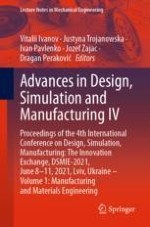2021 | OriginalPaper | Buchkapitel
Penetration Depth of the Critical Temperature into the Workpiece Material During Grinding
verfasst von : Vladimir Lebedev, Tatiana Chumachenko, Nataliya Klymenko, Olga Frolenkova, Serhii Yevtifieiev
Erschienen in: Advances in Design, Simulation and Manufacturing IV
Aktivieren Sie unsere intelligente Suche, um passende Fachinhalte oder Patente zu finden.
Wählen Sie Textabschnitte aus um mit Künstlicher Intelligenz passenden Patente zu finden. powered by
Markieren Sie Textabschnitte, um KI-gestützt weitere passende Inhalte zu finden. powered by
